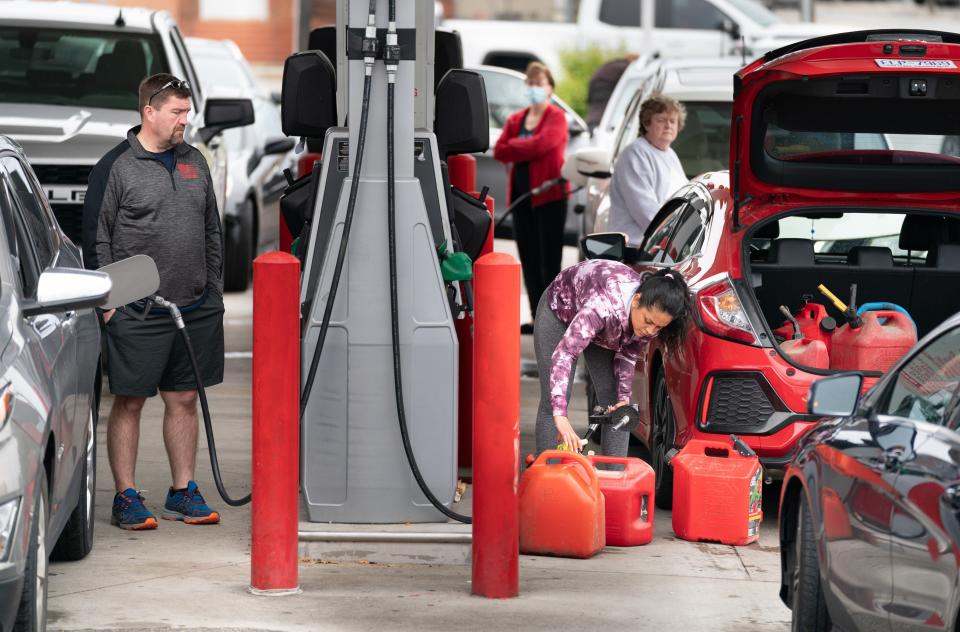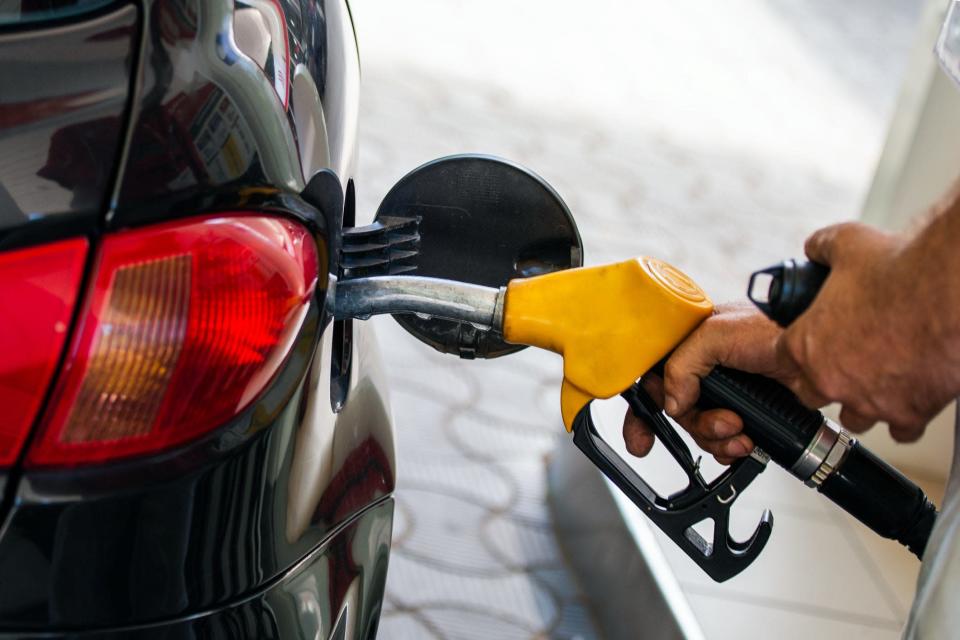Gas prices are up. What can Biden do to lower costs at the pump amid Russia’s invasion of Ukraine?
President Joe Biden has warned that defending freedom in Ukraine will cost Americans, and many are starting to feel the pinch at the pump.
The national average price for gasoline hit $3.66 a gallon on Wednesday, up 34% from a year ago, according to AAA.
“I will do everything in my power to limit the pain the American people are feeling at the gas pump,” Biden said last month. “This is critical to me.”
Consumers are looking to the White House to alleviate rising prices, but experts say the administration’s options are limited. Many expect average prices to hit $4 a gallon soon.
“I don’t know how much the president can do,” said Patrick De Haan, head of petroleum analysis at fuel-savings app GasBuddy. “It’s going to get ugly. It’s going to get real bad.”
OIL FROM RUSSIA: How much oil does the US buy from Russia? Not much, but gas prices are rising amid Ukraine invasion
RUSSIA INVASION OF UKRAINE: Could sanctions against Russia boomerang back on Americans?
Will gas prices go up because of Russia’s invasion of Ukraine?
Benchmark U.S. crude oil rose $7.19, to $110.60 a barrel, on Wednesday. Brent crude, the world benchmark, rose $7.96 to $112.93 a barrel.
That’s despite the U.S. and its allies agreeing Tuesday to release 60 million barrels of oil from their strategic reserves, half of which would come from the U.S. stockpile. Both oil and gas prices continued to climb following the announcement.
Robert Yawger, director of energy futures at financial company Mizuho, said the release was too little, too late, to make any significant impact on the market.
“We’ve already been here, we’ve already done that,” he said, pointing to the Biden administration’s decision in November to release 50 million barrels of oil from the nation’s emergency reserves.
While the value of crude oil dipped after the announcement in November, prices were back to where they had been less than two months later, and have continued to climb.
“It didn’t really leave much of an impression,” Yawger said. “We’re in desperate times to a certain degree. And with Russia, the second-biggest producer in the world … threatening to be off the market, it’s a semi-desperate situation.”

This isn’t the first time international conflict has driven up gas prices in the U.S. The same thing occurred during the Gulf wars in the 1990s and 2000s.
But Yawger said prices were “way higher” now due to inflation.
“This has taken us to the next level,” he said.
WILL GAS PRICES KEEP RISING?: Here’s what we know
FACT CHECK: Rising gas prices due to high demand and low supply, not Biden’s policies
What can Biden do to lower gas prices?
So what can the Biden administration do at this point to help consumers’ wallets?
Not much in the short term, according to experts. Samantha Gross, a fellow and director of the Energy Security and Climate Initiative at the Brookings Institution, said presidents are limited when it comes to controlling gas prices.
“There’s actually not a lot that American presidents can do about gasoline prices,” Gross said. “The president has precious few levers.”
Here are some options experts said the administration may be considering:
Draw from the Strategic Petroleum Reserve
Biden on Tuesday said the release of 30 million barrels of oil from reserves should “help blunt gas prices here at home,” and the country stands ready to release more oil from its reserve “if necessary.”
De Haan said 30 million barrels is “way too small” to get the market’s attention.
“That’s nothing,” he said. “These reserves cannot offset what a major oil producer is churning out on daily basis. They are finite – once that oil reserve is gone, it’s gone,” he said. “It should not be the sole tool that the president’s utilizing.”
Yawger said officials could remove more from the reserves, but believes it to be unlikely since the administration would need to remove a significant amount to impress the market.
When asked how the administration could lower costs, Yawger said their options are limited.
“I’m just glad I’m not a politician that has to answer that,” he said.
Crude oil storage levels in the Strategic Petroleum Reserve were at nearly 594 million barrels in December – their lowest since 2002, and that’s before the U.S. agreed to release another 30 million barrels.
“We are at deep-down levels,” Yawger said. “We’re not going to a ‘Mad Max,’ fighting for gas kind of situation any time … but it could get rather pricey.”

Lift the gas tax
Suspending the federal gas tax is another option. White House press secretary Jen Psaki said Feb. 15 that “all options remain on the table” when it comes to finding ways to bring down gas prices, including the federal tax that adds about 18 cents per gallon of gas.
A group of Senate Democrats, led by Sens. Maggie Hassan, D-N.H. and Mark Kelly, D-Ariz., has proposed legislation that would eliminate the federal gas tax through the end of the year. But the proposal has run into resistance from both Republicans and some Democrats, making it a longshot to pass in the Senate, which requires 60 votes to overcome a filibuster.
Will McBride, vice president for federal tax and economic policy at the Tax Foundation, believes that would be a mistake, since the tax helps fund highways. Taking away that source of revenue could further debilitate the national infrastructure.
“(Highway funds are) already under a lot of pressure,” McBride said. “That (18 cents) is not a large part of the price of a gallon of gas,” but added that won’t stop politicians from suggesting a suspension of the gas tax to lower prices.
ENERGY PRICES: What does Ukraine invasion mean for energy bills?

Keep using winter gasoline
De Haan of GasBuddy advocated federal officials issue a waiver that would allow winter-blend gasoline (which allows gasoline to ignite more easily to start cars in colder temperatures) to be sold in the warmer spring and summer months to save consumers money.
Winter gasoline is cheaper to produce, which results in lower gas prices at the pumps from late September through late April, according to GasBuddy.
“The change to summer gasoline (is) usually something that boosts prices by 25 to 75 cents a gallon,” DeHann said
The downside to issuing waivers to continue using winter blends is that they do not burn as cleanly as summer blends. Extending the use of winter blends could be a hard sell to an administration that has pushed for lowering emissions.
More on Ukraine
• Resource fight:Russia may retaliate against Europe by halting natural gas exports
• Russian people: How sanctions will impact ordinary Russians
• Boomerang: Could sanctions against Russia blow back on Americans?
Increase supply
De Haan also pointed to increased production as a way to offset rising costs, something that could be accomplished through a new nuclear deal with Iran. The country’s oil has been sanctioned since 2018, when then-President Donald Trump withdrew the U.S. from the Joint Plan of Action.
The country produces roughly 2 million barrels of oil a day – less than one-fifth of Russia’s production rate, but it’s “still something,” according to De Haan.
Psaki on Feb. 25 said “we’re not quite at the point of a final deal on the nuclear deal,” adding that the administration would discuss other options “if we get to that point.”
McBride added that increasing production within the U.S. could help ease pump prices. Production has been down since the start of the pandemic, and Secretary of Energy Jennifer Granholm said in November that the administration wanted to encourage oil companies to increase supply both within and outside the U.S.
Gross predicted Biden would also turn to OPEC for any additional capacity it might open during the crisis.
Psaki said the White House’s focus was “engaging with a range of countries,” pointing to Japan as an example, about diverting some of its excess natural gas supply to Europe, which could see its energy market most disrupted by the Ukraine crisis.
“We’re seeing some encouraging developments on that front,” she said.
But McBride noted that ramping up output would take “several months.”
“I’m afraid it simply can’t be solved in the short term; the price can’t effectively come down,” he said. “This is, unfortunately, going to be borne by consumers.”
The biggest step Biden has taken to limit a spike in energy prices in the U.S., Gross said, is opting not to directly sanction Russia’s energy market.
“They’re doing things to not make the situation worse, and that is not nothing,” she said.
As Russia continues its brutal assault on Ukraine, the president has not ruled out targeting Russia’s oil industry.
“Nothing is off the table,” Biden said Wednesday when asked whether the U.S. will ban Russian oil imports.
RUSSIAN INVASION’S IMPACT ON ENERGY: Russia may retaliate against Europe by halting natural gas exports — if Europe doesn’t do it first
When will gas prices drop?
McBride expects to see an all-time high in oil prices if the conflict in Ukraine continues “for more than a few days.”
De Haan expects gas prices to hit an all-time record within a month.
“By April Fool’s, we could be setting new record highs. … I wish it was a joke,” he said. “Prices are going to keep going up until there’s a point where it breaks people down and it slows down demand. And that point could be very high.”
Yawger noted that prices could drop as temperatures warm and Europeans use less natural gas to warm their homes but noted that if prices do get past $4 a gallon at the pump, it could impact voter sentiment.
“Once we start paying $4 at the pump … there is going to be just a general outcry,” he said. “We can get there rather quickly. It could be this weekend, next weekend type of thing. So it’s imminent. It does not look good.”
This article originally appeared on USA TODAY: Gas prices are high and rising. What can Biden do to lower costs?




